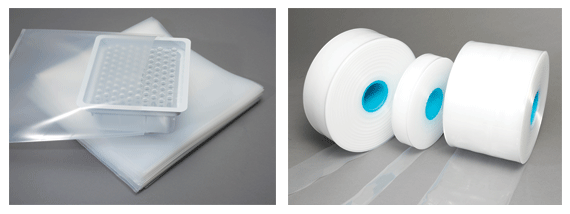When packaging material that is to be used for packaging cleanroom products has been produced at a lower quality hygiene level than cleanroom conditions, it can become a source of contamination in the cleanroom.
Cleanroom bags and films produced under Good Manufacturing Practice (GMP) guidelines in a cleanroom environment provide an effective solution to protect against contamination throughout the cleanroom supply chain.
Because packaging materials are in direct contact with the end product, all contamination risks concerning raw material, process and logistics have to be detected and eliminated.
GMP and cleanroom production
Manufacturing and packing under cleanroom conditions needs to become a standard process if products are to meet the highest levels of hygiene and cleanliness.
This is particularly necessary for the pharmaceutical, medical device, life science and healthcare sectors. But it also affects technology-based industries such as optics, laser, automotive, aerospace and electronics.
By its very nature, the pharmaceutical industry is often a leader in quality, hygiene and cleanliness. It created the GMP guidelines that stipulate the quality requirements, covering all the structural components and process elements.
Therefore, it is appropriate to identify the GMP philosophy as an ‘industrial mega trend’.
Packaging is the focus of several parts of the GMP guideline, and is discussed on a similar level to starting materials: ‘The selection, qualification, approval and maintenance of suppliers of primary and printed packaging materials shall be accorded attention similar to that given to starting materials. ...’ (GMP Chapter 5).
Thus packaging materials have to meet the same quality level as raw materials – not surprising, as they are in direct contact with the products and thus become a significant quality parameter.
In addition, such packaging materials are also to be used in GMP or cleanroom environments where they may touch both products and equipment surfaces, such as work benches, machines or tools.
Finally employees are also handling the packaging materials.
There are no two ways about it – packaging material needs to be qualified for GMP and cleanroom applications.
Guidelines and info
There are many regulatory guidelines that deal with this issue, including:
- DIN ISO 15378 (primary packaging materials for medicinal products
- DIN ISO 15593 (Management of hygiene in the production of packaging for foodstuffs – Requirements)
- DIN ISO 14644 (Cleanrooms and associated controlled environments), and l VDI 2083 (Cleanroom technology – especially Chapter 9.2 Consumables in the cleanroom).
In contrast to these process-focused guidelines, the European and US Pharmacopoeia guidelines and VDI 19 (Technical cleanliness) standard focus more on product quality.
Plastic materials
The only way to achieve the extreme requirements with regard to hygiene and cleanliness is to use cleanroom packaging materials.
This applies for pharmaceutical and chemical substances as well as for plastic components, implants, pumps, tubes, bottles, caps and plastic or glass primary packaging.
Before leaving the cleanroom areas, the products must be packed carefully to protect them against damage and contamination during transport and handling.
For these operations plastic films, tubes and bags are the most frequently used packaging materials across the cleanroom supply chain.
All companies that form part of this supply chain have to deal with potential contamination risks during handling, shipping and storing.
This indicates that, on every supply chain level, packing materials need to reach a primary packaging quality status.
Contamination and the risk it poses is becoming more and more important. Every packaging process and material needs to be GMP-qualified and validated.
Contamination risks
Packaging contamination risks can be clustered into four groups:
1. Material risks: First, the conformity of raw materials has to be checked. Migration between packaging material and product has to be eliminated absolutely, because this may change important product quality properties.
2. Process risks: These result from handling activities, for example, particle emission during the packaging process.
3. Further risks are determined by the packaging process. Most significant is the risk of contaminating the cleanroom production areas and cleanroom products via use of low quality packaging materials.
4. Handling risks: All consumables and disposables that have to be transferred into the cleanroom need to be packed, and all products that leave the cleanroom have to be packed as well. The amount of packaging depends on the cleanroom zone concept.
5. Product risks: This involves technical parameters such as seal strength, leakage, pinholes and sealability.
GMP material use to eliminate risks
The only way to eliminate these risks is to use GMP-qualified packaging materials. This implies a packaging manufacturer with cleanroom facilities and GMP-qualified production systems.
But the key factor is intensive co-operation and networking between customer and packaging manufacturer.
Together they have to respect one basic principle for packaging specifications: packaging materials for use in cleanroom areas have to comply with the same quality requirements that the cleanroom end products have to achieve.
The market is becoming ever more aware of contamination issues and the solution is cleanroom packaging materials.

STRUBL Packaging is a specialist cleanroom packaging company that develops and supplies blown film and flat film, bags, side gusseted bags, bag systems (double/triple) and sterilisation bags for cleanroom products.
These packaging products are produced in an ISO cleanroom production environment with an integrated GMP system supported by an ISO 9001 and ISO 15378 quality management system. STRUBL created a continuous process covering order fulfilment, operations and logistics. This involves: cleanroom production, hygiene management, housekeeping, monitoring, pest control, risk analysis, traceability, documentation and specification, validation and qualification.
With more than 65 years of experience in the plastic packaging market, STRUBL is a dedicated partner for customers in the pharmaceutical, medtec, healthcare, food and life science sectors. The company’s whole operating procedure is based on a GMP philosophy, where teamwork, training and continuous improvement are the fundamentals of success. An annual increase of 15-20% in sales volumes affirms the company’s strategic decision to establish this cleanroom packaging business. For details visit www.cleanroompackaging.eu
